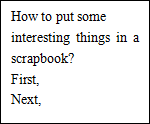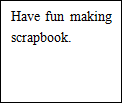Unit3Topic1 SectionC 教学设计
Ⅰ. Material analysis
本节课主要活动为1a和2。
Section A引出了爱好的话题,Section B谈论了过去及现在的爱好,Section C以举例的方式,具体讲述某一种爱好。通过介绍scrapbook的制作,呈现了单词background, paper, glue, scissors, stick, friendship, stupid等。通过scrapbook的制作过程,引出在谈论事情或制作的时候需要注意条理性。在2中也将used to do sth延伸到特殊疑问句形式。本课要求学生能读懂本篇文章,并能模仿scrapbook的制作过程,制作出集邮册、留言册等,并能够用英文讲述其制作过程。这样的话题要求学生动手参与,实用性强,学生非常感兴趣。
Ⅱ. Teaching aims
Knowledge aims:
1. 能根据音标,正确朗读出单词表中黑体单词及短语:background, paper, glue, scissors,
stick, friendship, stupid等。
2. 能正确拼读并运用单词: friendship, funny, stupid, ugly, background, paper, scissors...
3. 能正确、熟练地应用used to do sth以及prefer/ like /enjoy/ be interested in doing sth。
4. 能使用表示顺序的词如: first, second, next等写一份简单的制作说明书。
Skill aims:
1. 能基本听懂本课文本材料,及他人对爱好的阐述。
2. 能正确地口头介绍scrapbook的制作流程。
3. 能正确朗读课本的文本材料,并能读懂相关的文本材料。
4. 能正确模仿本课课文,通过书面形式介绍一种自己的爱好。
Emotional aims:
通过对课文的学习,要求学生能模仿scrapbook的制作过程,做出自己喜欢的东西,在制作过程中养成互帮互助和认真倾听他人建议的好习惯,让学生感受美好的事物都需靠勤劳的双手来创造。
Ⅲ. The key points and difficult points
Key points:
1. 学习表示顺序的词如: first, second, next等。
2. 复习表示喜好的短语、单词:used to do sth, prefer/ like /enjoy/ be interested in doing sth.
Difficult points:
熟练应用used to do sth 的各种形式。
Ⅳ. Learning strategies
1. 训练学生通过标题预测课文的能力。
2. 阅读时认真观察图片或者名字会为把握文章大意提供帮助。
3. 通过实践参与制作,能在制作过程中发现并解决问题。
Ⅴ. Teaching aids
Computer multimedia projector, glue, scissors, background paper
Ⅵ. Teaching procedures
Step |
Interaction pattern |
Student activity |
Teacher activity |
|
1. The whole class work 2. The whole class work |
1. Focus their attention on the teacher. 2. Listen to the teacher carefully. |
1. Greet students ready for learning. 2. Play a game to warm students up. Who is the cleverest in our class? |
Introduction (4 minutes) |
3. Group work 4. Group work 5. The whole class work |
3. Discuss and hand up. (English or Chinese) 4. Discuss this question in groups. Maybe each student has his/her own idea, but they should say, “First, take out the elephant; second...” 5. Think and discuss. Chinese is OK, because there may be so many new words. |
3. Ask this question “How to put an elephant into the refrigerator?” (Give them smiling faces if their answers are reasonable.) 4. Give another question “How to put a tiger into the refrigerator?” (Guide students answer this question with “first, second, third…”) 5. Show the third question “How to put some interesting things into a scrapbook?”. Show the object and teach the words “background paper” at the same time. Don’t check the answer immediately. Let them think. Write the question on the blackboard. |
Presentation (10 minutes) |
1. The whole class work and group work 2. The whole class work 3. Individual work 4. Individual work 5. Individual work and group work |
1. Think and discuss how to speak them in English. They may look them up in the words list or some other ways to get the names. Anyway, they are attracted by them. 2. Read these words carefully and follow the teacher. 3. Remember these words and predict the passage under the mention. (prediction can help us understand the whole passage very well.) 4. Students find the sentence “Scrapbooking is a hobby.” and “Today people collect many things in scrapbooks.” at once. They can give the passage a name that is “Scrapbooking”. 5. (1) Finish 1b after they find out the topic sentence of paragraph. (2) Check the answer in groups. |
1. Ask students to look at the tools on the teacher’s desk carefully. Ask, “Can you name them?” 2. At this time, teach students the new words by showing the objects. Ask students to remember them according to the pronunciations. 3. Finish 1a. Provide students 2 or 3 minutes to remember these words and ask students to predict what they will learn according to the pictures on Page 59 and the tools on the teacher’ s desk. 4. Finish 1b 1. Teacher asks the students to skim 1a and find out the topic or general idea as quickly as they can. Tell students the topic sentence will help them understand the passage. 5. Finish 1b 2. Teacher asks the students to scan 1a and answer the question: Since we will make a scrapbook, do you know what may people collect in scrapbooks today? |
Consolidation (15 minutes) |
1. Group work 2. Group work and individual work 3. Group work and individual work 4. The whole class work and individual work 5. Group work and individual work |
1. Students imitate Paragraph. They may say “I will put pictures with my friends, many famous star cards, game cards... in it.” Look up some words in the dictionary or use other words to express the same meaning. 2. Find the answer from paragraph 3. They can find “first, next…” 3. Discuss in groups. Each student has his/her own idea. 4. Fill in the blanks according to their memories. They also can open the book if they can’t remember. 5. Students retell this passage in groups. And then hand up. |
1. Finish 1b 4. Let students Discuss: If they have a chance to make a scrapbook, what will they collect in their scrapbooks? Walk around the classroom, students may have many words they can’t express. Tell them they can ask the best teacher—dictionary--for help. 2. After they know what to collect, ask students to read 1a again carefully and find out how to start to make a scrapbook. 3. Finish 1b 3. Ask students to discuss “ How do you make a scrapbook?” Remind students to imitate the text book “first, next,…” 4. Design a task for students. Ask them to fill in the blanks. Teacher takes out some words (new words or key words or phrases) from 1a. 5. Ask students to retell the whole passage according to the task. Tell them to use their own words. |
Practice (6 minutes) |
1. The whole class work and pair work 2. Pair work and group work |
1. The student answers this question. Maybe “Yes”, add the question of “What did you use to collect?” If the answer is “No”, he should answer “What did you use to do?” 2. Ask and answer these two questions in pairs. Find each other’s mistakes. |
1. Guide students to review “used to do sth”. Make sure they can use this phrase correctly. Leading in this part, teacher says, “From this passage, we know scrapbooking is a hobby. It was one of my hobbies several years ago. I used to collect many famous stars’ photos and stamps in it.” Ask a student, “How about you? Did you use to collect things in the scrapbook?” 2. Finish 2. Tell students that hobbies may change as time goes by. Ask students to look at part 2 and discuss “What do Kangkang and Michael often do in different seasons now?” and “What did they use to do in the past?” |
Production (10 minutes) |
1. The whole class work and group work 2. The whole class work and individual work 3. The whole class work 4. Individual work 5. Individual work |
1. Discuss how to make a class book. Consider the following aspects :What to collect? How to make it? First, Second, Why to make it? Friendship, beautiful. Imitate 1a. 2. Share their opinions. Some volunteers come to the platform to demonstrate it. 3. All the students should know the meanings of the summary and know how to make a scrapbook. 4. Read 1a and 3 carefully. Find some important information that can be used in the passage. 5. Students review Sections A-C to prepare for Section D. |
1. Finish 3. Peter in our class was ill. He wants to do a class book. Ask students to discuss how to make a class book. Part 3 may give them help. 2. Ask students to share their opinions. Invite volunteers to make it on the platform. Other students give their advice. 3. Teacher summarizes what the students learned today: some new words, some key words and the way of doing a scrapbook. 4.Teacher assigns homework: (1) Make a scrapbook, a class book or something like this. ( (2) Write down how do you make the book. 5.Teacher assigns the students to review Sections A-C to prepare for Section D. |
Teaching Reflection |
This class is related to students’ life very much. They can find it very useful. They like it a lot. Most students know topic sentence is very important when they are reading. But writing a passage about how to make a class book without looking up the textbook is difficult for them. |
Ⅶ. Blackboard design
Unit 3 Our Hobbies Topic 1 What’s your hobby? Section C  G1 G2 G3 G4 G1 G2 G3 G4


 

 

|

